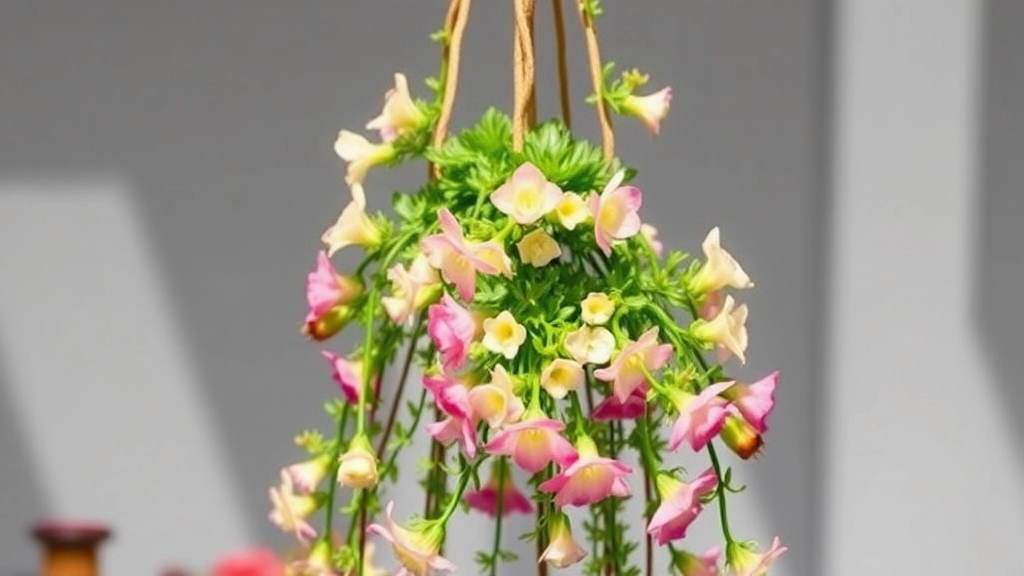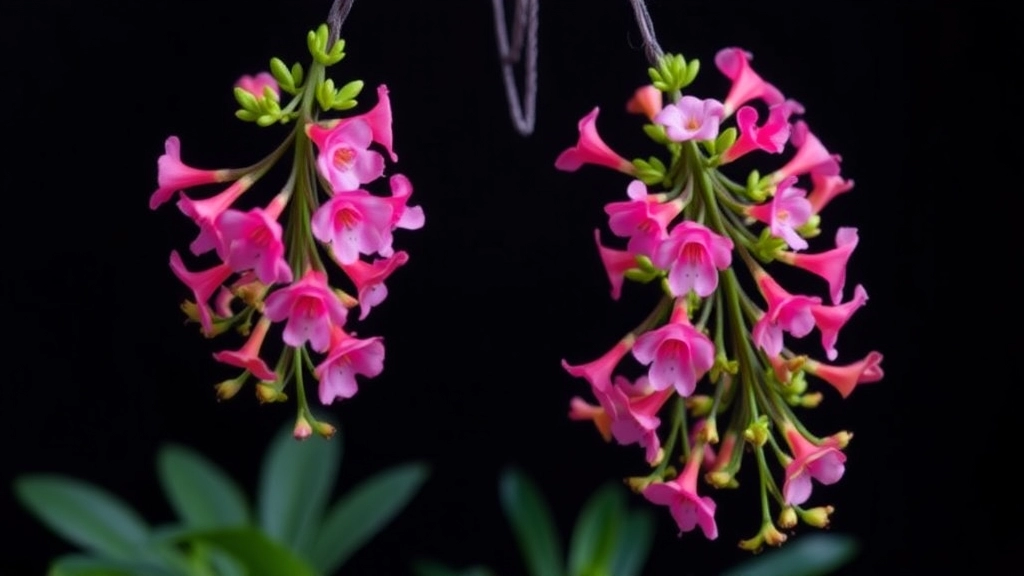How to Care for a Chandelier Plant Kalanchoe Tubiflora
Ever wondered how to care for a Chandelier Plant Kalanchoe Tubiflora? You’re in the right place. This unique plant, with its tall, slender leaves dotted with baby plantlets, can be a striking addition to your indoor garden. But like any plant, it has its own set of care instructions to thrive.
Care Instructions
First things first, ensure it’s getting plenty of sunlight. A sunny windowsill is ideal. Water sparingly; overwatering can lead to root rot. Keep the soil well-draining and let it dry out between waterings. And remember, a little bit of neglect is sometimes the best care for a Chandelier Plant Kalanchoe Tubiflora.
Overview of Chandelier Plant (Kalanchoe Tubiflora)
Are you curious about the Chandelier Plant, also known as Kalanchoe Tubiflora?
This striking succulent is not just a visual delight; it’s a resilient plant that can thrive in various conditions.
Originating from Madagascar, the Chandelier Plant is celebrated for its unique appearance, featuring cascading leaves that resemble a chandelier.
Key Features:
- Distinctive Leaves: The plant showcases fleshy, elongated leaves that can grow up to 30 cm long.
- Flowering: In the right conditions, it produces clusters of small, tubular flowers, typically in shades of pink, red, or yellow.
- Growth Habit: Known for its ability to produce “plantlets” along the edges of its leaves, which can easily take root and grow into new plants.
Environmental Impact:
Kalanchoe Tubiflora is not only beautiful but also plays a role in its ecosystem by providing habitat and food for various pollinators.
For those looking to add an eye-catching element to their indoor or outdoor spaces, the Chandelier Plant is a fantastic choice. If you’re interested in other unique varieties, check out our guide on the top Kalanchoe succulent varieties and care tips. Additionally, for those curious about the medicinal uses of Kalanchoe, our article on Kalanchoe Brasiliensis medicinal uses and health benefits is a must-read.
Ideal Growing Conditions for Chandelier Plant (Kalanchoe Tubiflora)

So, you’ve got your eye on the Chandelier Plant, huh? Great choice! But before you dive in, let’s chat about what this beauty needs to thrive.
Light Requirements
First off, light is key.
- Bright, Indirect Light: Kalanchoe Tubiflora loves a good sunbath but not too much direct sunlight.
- East or West Window: These spots are perfect for getting that sweet spot of light without scorching the leaves.
Temperature and Humidity
Next up is temperature.
- Ideal Range: Keep it cozy between 15°C to 25°C.
- Avoid Frost: This plant is not a fan of frosty conditions. If you live in a colder climate, bring it indoors when temperatures drop.
Soil Preferences
Now, let’s talk dirt.
- Well-Draining Soil: A mix designed for succulents is your best bet. Think sandy or gritty.
- pH Level: Aim for a slightly acidic to neutral pH, around 6.0 to 7.0.
Watering Needs
And then there’s watering.
- Less is More: Kalanchoe Tubiflora prefers to dry out between waterings.
- Check the Soil: Stick a finger in the soil; if it’s dry a couple of inches down, it’s time to water.
Fertilizing
Finally, let’s sprinkle in some nutrients.
- Light Feeding: During the growing season (spring and summer), a diluted cactus fertilizer once a month will do wonders.
- Skip in Winter: No need to fertilize when it’s resting.
Propagation Techniques
When considering how to propagate your Chandelier Plant (Kalanchoe tubiflora), you might be wondering about the best methods to ensure success. Propagation can seem daunting, but it’s a rewarding way to expand your collection or share this stunning plant with friends.
Leaf Cuttings
One of the simplest methods for propagating Kalanchoe tubiflora is through leaf cuttings. Here’s how to do it:
- Select a Healthy Leaf: Look for a mature, healthy leaf that’s free from blemishes.
- Cut the Leaf: Use a clean, sharp knife to cut the leaf from the stem.
- Let it Callous: Place the leaf in a dry, warm area for a few days to allow the cut end to callous over. This prevents rot when planted.
- Plant the Leaf: Once calloused, place the leaf in well-draining soil, burying just the cut end.
- Water Sparingly: Lightly mist the soil and keep it slightly moist, but avoid overwatering.
Offsets
Kalanchoe tubiflora is known for producing offsets, or “pups,” which can be easily separated and planted:
- Identify Offsets: Look for small plants growing at the base of the parent plant.
- Gently Remove: Carefully detach the offset from the main plant, ensuring some roots are attached.
- Replant: Place the offset in its own pot with well-draining soil.
- Water: Water lightly and keep the pot in a warm, bright location.
Seed Propagation
While less common, you can also propagate Kalanchoe tubiflora from seeds:
- Obtain Seeds: Purchase seeds from a reputable supplier or collect them from a mature plant.
- Prepare Soil: Use a seed-starting mix that drains well.
- Sow Seeds: Sprinkle seeds on the surface of the soil and lightly cover them.
- Maintain Moisture: Keep the soil moist but not soggy, and place the tray in a warm area with indirect light.
By employing these propagation techniques, you can easily expand your Chandelier Plant collection and share its beauty. For more detailed information on Chandelier Plant care and propagation or to explore different Kalanchoe species, check out our other guides.
Common Issues and Solutions

As we delve deeper into caring for the Chandelier Plant, it’s essential to address some common issues you might encounter. Understanding these challenges can make a significant difference in maintaining a healthy Kalanchoe tubiflora.
1. Overwatering
One of the most frequent problems with Kalanchoe tubiflora is overwatering. This succulent prefers dry conditions, and too much moisture can lead to root rot.
- Solution:
- Allow the top inch of soil to dry out before watering again.
- Use well-draining soil and pots with drainage holes.
2. Underwatering
Conversely, underwatering can also pose a threat. If the leaves appear shrivelled or wrinkled, your plant may not be getting enough water.
- Solution:
- Water thoroughly, ensuring the soil is moist but not soggy.
- Adjust your watering schedule based on the season; plants typically need more water during the growing season (spring and summer).
3. Pests
Pests like aphids and mealybugs can invade your Chandelier Plant, causing stress and damage.
- Solution:
- Regularly inspect your plant for signs of pests.
- Use insecticidal soap or neem oil to treat infestations.
4. Leaf Drop
If you notice leaves dropping, it could be a sign of stress from temperature fluctuations or improper light conditions.
- Solution:
- Ensure your plant is in a stable environment away from drafts.
- Provide bright, indirect sunlight to keep it thriving.
5. Fungal Issues
Fungal infections can occur, particularly in humid conditions or with overwatering.
- Solution:
- Improve air circulation around the plant.
- Use a fungicide if necessary and avoid watering from above.
Benefits and Uses of the Chandelier Plant
As we explore the myriad benefits of the Chandelier Plant, or Kalanchoe tubiflora, it’s essential to acknowledge its unique characteristics that make it a valuable addition to any home or garden.
Aesthetic Appeal
One of the most striking features of the Chandelier Plant is its visually appealing, cascading leaves.
- Vibrant Greenery: The lush foliage adds a touch of elegance to indoor spaces.
- Unique Shape: Its distinctive leaf structure creates an eye-catching display, perfect for hanging baskets.
Air Purification
Many houseplants are celebrated for their air-purifying qualities, and the Chandelier Plant is no exception.
- Toxin Removal: This plant can help filter harmful substances from the air, contributing to a healthier living environment.
- Oxygen Production: As a succulent, it performs photosynthesis efficiently, releasing oxygen even at night.
Medicinal Uses
The Chandelier Plant has a history of traditional medicinal applications.
- Wound Healing: Some cultures use its leaves to treat minor cuts and bruises.
- Anti-inflammatory Properties: The plant is believed to have natural anti-inflammatory effects, making it popular in herbal remedies.
Easy Care and Maintenance
One of the standout advantages of the Chandelier Plant is its low maintenance requirements.
- Drought Tolerant: It thrives on neglect, making it ideal for busy individuals.
- Adaptable: This plant can flourish in various light conditions, from bright indirect light to partial shade.
Educational Value
For those interested in botany or gardening, the Chandelier Plant serves as an excellent educational tool.
- Propagation Experiments: Its ability to propagate easily from leaf cuttings is a fantastic way to learn about plant reproduction. For a detailed guide, check out our step-by-step guide on propagating Kalanchoe Pink Butterflies.
- Succulent Studies: Being a succulent, it provides insights into water conservation in plants. Learn more about the care of Kalanchoe Blossfeldiana hybrids to expand your knowledge on succulent care.
Seasonal Care Tips for Your Chandelier Plant
So, you’ve got a Chandelier Plant (Kalanchoe tubiflora) and you’re wondering how to keep it thriving throughout the seasons? You’re not alone! Many plant lovers worry about how to adjust their care as the weather changes.
FAQs about Chandelier Plant (Kalanchoe Tubiflora)
What kind of light does the Chandelier Plant need?
The Chandelier Plant thrives in bright, indirect light. An east or west window is ideal to provide the right amount of light without scorching the leaves.
What is the ideal temperature range for growing Kalanchoe Tubiflora?
The ideal temperature range is between 15°C to 25°C. It’s important to avoid frost as this plant does not tolerate cold conditions well.
What type of soil should I use for my Chandelier Plant?
Use well-draining soil, preferably a mix designed for succulents. Aim for a slightly acidic to neutral pH, around 6.0 to 7.0.
How often should I water my Kalanchoe Tubiflora?
Watering should be done sparingly. Allow the soil to dry out a couple of inches down before watering again. Remember, less is more when it comes to watering this succulent.
Do I need to fertilize my Chandelier Plant?
Yes, but only lightly during the growing season (spring and summer). Use a diluted cactus fertilizer once a month. There’s no need to fertilize during the winter.
What should I do if my Chandelier Plant is overwatered?
Overwatering can lead to root rot. Allow the top inch of soil to dry out before watering again and ensure you use well-draining soil and pots with drainage holes.
How can I tell if my Chandelier Plant is underwatered?
If the leaves appear shriveled or wrinkled, your plant may not be getting enough water. Water thoroughly, ensuring the soil is moist but not soggy, and adjust your watering schedule based on the season.
What should I do if pests invade my Chandelier Plant?
Regularly inspect your plant for signs of pests like aphids and mealybugs. Use insecticidal soap or neem oil to treat infestations.
Why are the leaves on my Kalanchoe Tubiflora dropping?
Leaf drop can be a sign of stress from temperature fluctuations or improper light conditions. Ensure your plant is in a stable environment away from drafts and provide bright, indirect sunlight.
How can I prevent fungal issues in my Chandelier Plant?
To prevent fungal infections, improve air circulation around the plant and avoid watering from above. Use a fungicide if necessary.
References
-
The Spruce – Growing Kalanchoe Tubiflora
-
Succulent City – Kalanchoe Tubiflora Care Guide
-
Gardenista – Kalanchoe Tubiflora: Mother of Thousands
